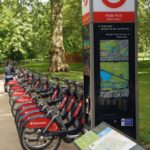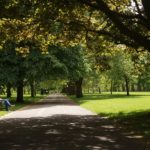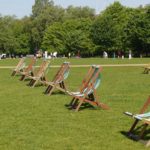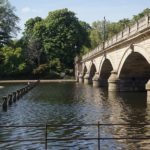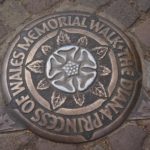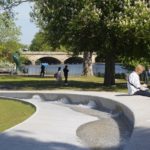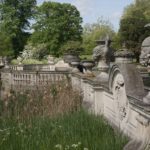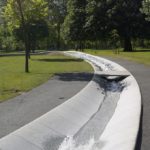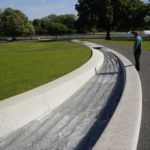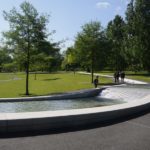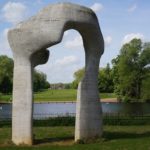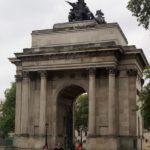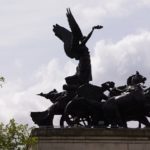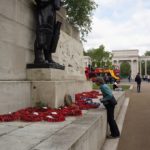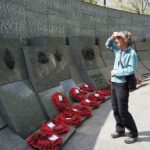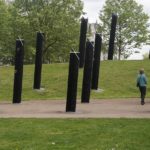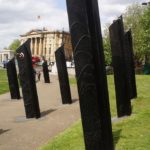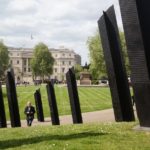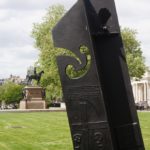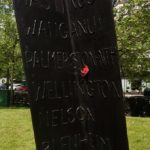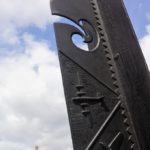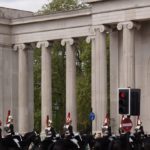Our heads and our hearts are still confused and bewildered with the effects of jet lag. Flying is a strange experience. Crammed so closely together with strangers in a steel tube. Emerging now and then into the unnatural spaces that are airport terminals. These spaces are divorced from reality, no sense of place or time. Outside it can be dark or light, hot or cold, dry or wet, Antarctica or Abu Dhabi. Who would know? The world may have ended. Inside the terminal it is always the same artificial environment, everywhere in the world, probably everywhere in the universe. They are populated by Zombies wandering around with crooked necks looking up at the slowly changing secret codes on huge screens. Dreading the sight of the cursed words ‘Flight Delayed’.
We needed to get our heads together, not yet ready for the noise, the intensity, the pace of a great city. For me the best thing about London is its open spaces. 47% of London is green space, there are 3,000 gardens, 8 million trees (the world’s largest urban forest) and 13,000 species including us. Seven royal parks, 45 square kilometres of public parks and gardens in the City of London.
So we spent most of the day in Hyde Park, one of the greatest city parks in the world and the old hunting ground of Henry VIII. It is the largest of four Royal Parks that form a chain through London. A quiet day wandering in the meadows enjoying a warm, sunny spring day. What follows is a description of three places of interest that appealed to us.
Diana, Princess of Wales Memorial Fountain. This an oval of Cornish granite slabs on the side of a gently sloping grassy hill. The oval is about 50m x 80m and the 545 slabs are shaped in many ways and form a channel like a stream bed. Water is pumped in at the top of the oval and flows down each side to meet at a pool at the bottom. One side of the stream bed descends fairly smoothly to the downhill end of the oval with gentle ripples; the other side consists of a variety of steps, rills, curves, and other shapes so that the water plays in interesting ways as it flows to the tranquil pool at the bottom. The two sides were intended to show two sides of Diana’s life: happy times, and turmoil.
You are allowed to sit on the edge of the channel and put your feet on, or walk in, the water. There are three little bridges so you can walk on the inside or outside of the oval. The play of light on the water is fascinating as it glides or slithers or tumbles over the various surfaces shaped into the granite. But the thing that interested me most was the sound. The artists Kathryn Gustafson and Neil Porter have created the sounds that water makes as it tinkles, splashes, surges or drips its way down the slope. All by just varying the shape and texture of the surface of the granite. At one point you swear large boulders are rumbling underwater down the slope but it is just the effect of some jets of water pushing up into a gentle flow of water.
Henry Moore Arch. This 6 metre high megalith of 7 large Italian travertine stones weighs nearly 40 tonnes and is shaped as an arch. It is located on the side of a grassy slope overlooking the Long Water of the Serpentine Lake. You can stand looking through the arch, across the Serpentine and through a long avenue of trees to Kensington Palace in the distance. It is a masterful composition but unfortunately is fenced off so you can’t walk through or around or touch the arch. Maybe because in the past it was deemed unsafe and has been disassembled, reinforced and reassembled.
The War Memorials. On a large traffic island opposite Hyde Park Corner, between Hyde Park and Green Park, there is a collection of war memorials. In the middle of the island and dominating everything else is the Wellington Arch. A victory arch proclaiming Wellington’s defeat of Napoleon. On top of a huge ceremonial classical arch, with heavy iron gates, sits the largest bronze statue in Europe depicting the Angel of Peace descending on Quadriga, the four horsed chariot of war.
Facing this is the Royal Artillery Memorial in a much soberer style. A stone and marble pile topped with a one third over-sized stone sculpture of a howitzer. Even with the over sizing, the gun seems like a toy compared to the huge sculptures of four artillerymen. Stone reliefs show realistic scenes from WWI, unusual at the time.
Next to this is the Australian War Memorial. This is a fairly modern grey-green granite semi circular curved wall in a slight dip forming an amphitheatre. The granite stones are inscribed with over 24,000 names of the villages and towns that Australian soldiers came from to go and fight our wars. You have to go up close as the names are quite small, about 25 mm high, but are cleverly inscribed so that standing further back you read in a much larger font the names of the 47 battles in which Australians have been involved, eg Lone Pine, Singapore, Gallipoli.
Opposite is the NZ War Memorial. This is in total contrast to all the other memorials on the traffic island and in my totally biased opinion easily the most symbolic. It comprises 16 heavy metal cross shaped girders projecting from the ground at an angle. From a distance the black painted girders look like the posture of warriors doing a haka, or the barrels of shouldered rifles, or soldiers in marching formation. The top of the girders are cut off at an angle and are polished and shiny and so they look like cross shaped grave markers. Up close the girders are decorated with texts, names, patterns, symbols, flowers, ferns etc symbolic of NZ.
The whole affair is set on a slightly sloping mound and the walking path goes right through it so you approach it from a distance, walk through it, see it close up, touch it. I think sculptor Paul Dibble and John Hardwick-Smith from Athfield Architects have done us proud but others have described it as ‘an infestation of public space’ and as ‘blisteringly unlovely’.
While at the war memorials a troop of The Queen’s Life Guard road past on immaculately groomed horses with breastplates shining in the sun. Each day they ride from the Hyde Park Barracks to Horse Guards Parade to change the Queen’s life guard. The is a different ceremony to changing the guard at Buckingham Palace.
- Iconic red buses
- Santander hire bikes
- Hyde Park
- Deck chairs and cricket, Hyde Park
- The Serpentine, Hyde Park
- Path way markers for the Diana Princess of Wales Memorial Walk
- Diana Princess of Wales Memorial Fountain
- Italian Water Gardens
- Diana Princess of Wales Memorial Fountain
- Diana Princess of Wales Memorial Fountain
- Diana Princess of Wales Memorial Fountain
- Henry Moore Arch, Hyde Park
- Wellington Arch
- The Angel of Peace on the Wellington Arch
- Royal Artillery Memorial
- Australian War Memorial
- NZ War Memorial
- NZ War Memorial
- NZ War Memorial
- NZ War Memorial
- NZ War Memorial
- NZ War Memorial
- The Queen’s Life Guard


